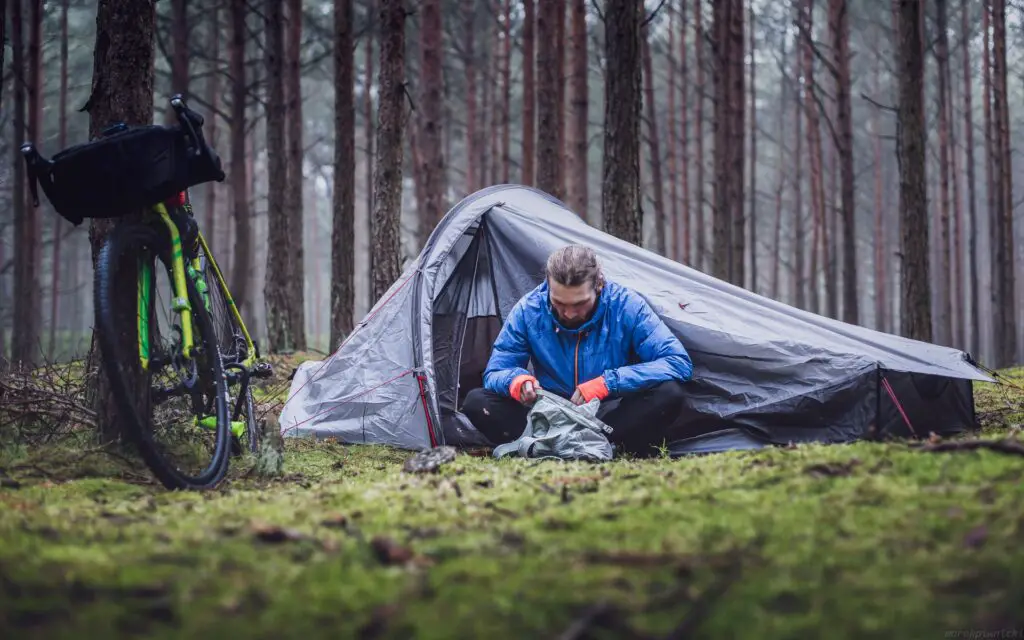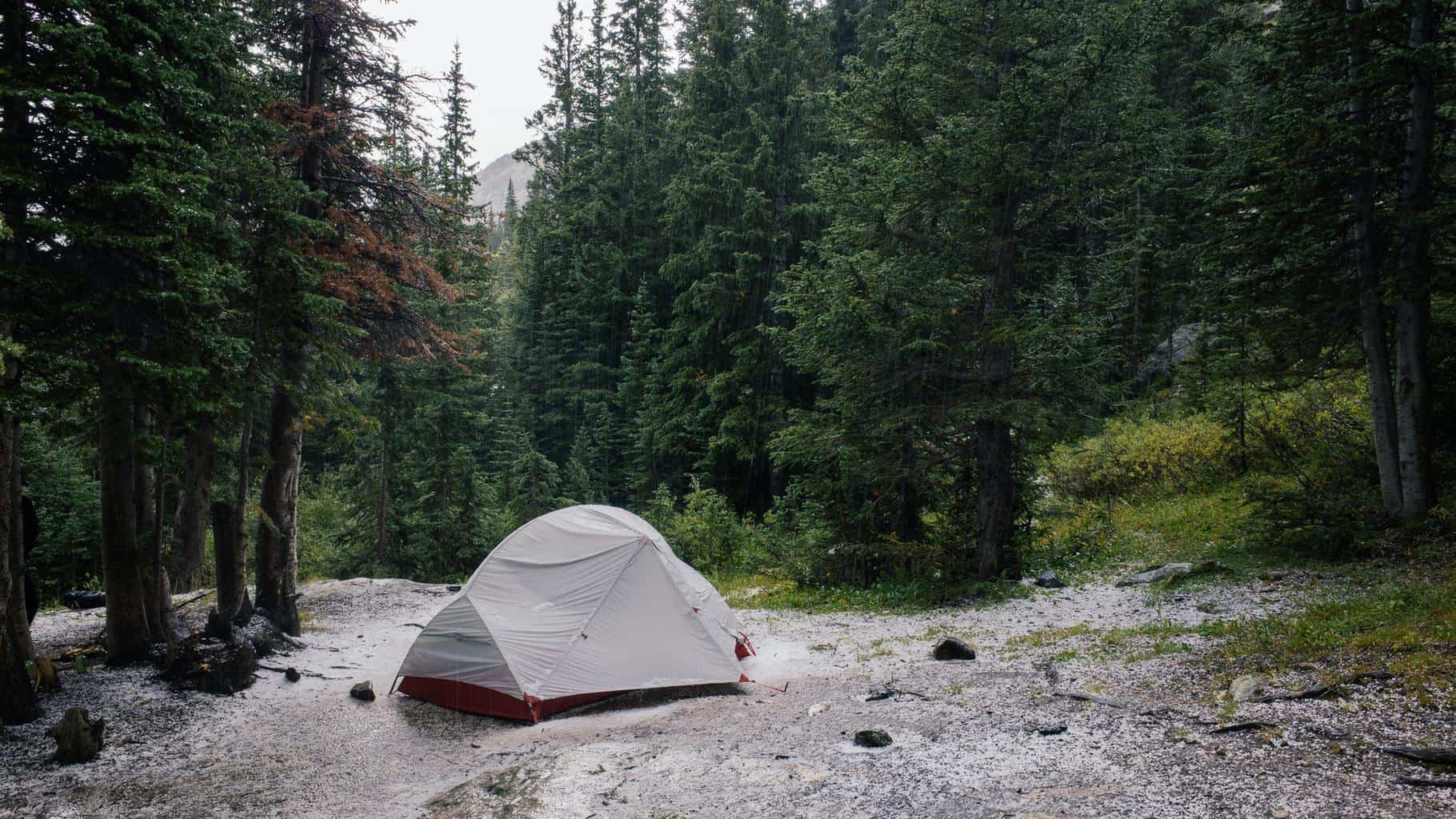Introduction
Tents need to serve a lot of purposes, but keeping you dry might be their most important job. The waterproof rating on tents – whether you’re looking for a dome tent, a Coleman tent, or a backpacking tent – is one of the most coveted design features.
Here, we’re telling you everything you need to know about this rating. We’ll explain the waterproof rating for a camping tent, how to read it, and other considerations you may not have contemplated.
What is a Waterproof Rating?
For the most part, it’s exactly what it sounds like, but it’s important to understand the details.
A tent’s waterproof rating will generally be listed in the “Tech Specs” of a tent’s details. You’ll find it listed in millimetres (mm). This mm rating represents the amount of water that a tent can withstand before it starts to leak.A tent will generally be rated between 1,000 mm and 10,000 mm.
You might think that the more waterproof, the better the tent. However, this isn’t always the case. Below, we’ll explain some trade-offs and considerations that are worth factoring before you buy a tent based on its waterproof rating.
How do They Measure Waterproofing?
The rating is measured using a test known as the Hydrostatic Head Test (HH Test). Basically, the tent’s material is attached to the bottom of a clear tube. That tube is then filled with water. The water is filled slowly so that it is clear whether the tent is leaking. Once three drops of water have leaked through the fabric, the test is completed. The quantity of water left in the tube represents the tent’s waterproof rating.
Sounds good right? You’ll surely want a tent that has more waterproofing than less. Especially when considering that you want to stay dry while camping. Well, yes and no. More waterproofing is great, but there are other important things to consider as well, some of which are directly related to a tent’s waterproof rating. We’ll check that out next.
Other Things to Consider in Waterproofing

More waterproofing isn’t always better. Here, we’ll examine some other factors you need to consider as well. These are related to a tent’s waterproof rating or directly affected by the rating itself.
Leaking at Seams
Above, we explained how a tent’s waterproof rating is measured. However, the HH Test only measures the waterproofing of the fabric itself. The problem is there are more places where the tent could potentially leak. The most obvious of these potential problem areas is the seams. An HH Test won’t measure the integrity of a tent’s seams.
This means that a tent which has a high waterproof rating might still have the problem of leaking at the seams, and this won’t be reflected in an HH test.The best way to rectify this problem is to buy a tent from a reputable brand. A high-quality tent manufacturer won’t risk its reputation with these misleading practices. Check out customer reviews to know for sure whether your tent is truly as waterproof as it claims.
The Weight
More waterproofing also tends to translate into a heaviertent. With tents, weight might be a primary concern. This is especially true if you are backpacking or trekking, and you need to factor the weight of your tent into your overall load.
Tents are often waterproofed by adding a layer of polyurethane coating to the fabric. Alternatively, tents might utilize a thicker or more water-repellant fabric to keep moisture out. Either way, this means more layers are added to the tent’s design, which results in a heavier tent.
The difference isn’t always a 1:1 ratio, as it still depends on the efficiency of the tent’s overall design. Buta higher waterproof rating will generally equate to a heavier tent.
Durability
As mentioned above, tents are often waterproofed by adding layers of polyurethane (PU) plastic coating. PU coating is considered 100% waterproof. However, multiple layers need to be added to ensure complete coverage.
The problem is that PU coating will also “stiffen” the tent’s surface, causing it to become more rigid. This rigidity can have a negative effect on the tent’s durability. A rigid tent is more prone to tearing, and less adept for handling harsh winds and weather conditions. Flexibility is important so the tent can reshape and adapt to weather conditions, and additional waterproofing makes it less able to do so.
Once again, it will depend how efficiently the tent is waterproofed. Higher-quality tents are able to do so without sacrificing as much durability. That being said, you can expect a more waterproof tent to be less flexible than the alternative. It’s all a very delicate balance.
Doesn’t Account for Wind-blown Rain

Another problem with the HH Test is that it doesn’t account for windblown rain. It simply accounts for a level of water sitting directly atop the tent fabric. However, if you’re in a particularly windy rainstorm, you can expect even more rain to blow onto your tent.
There isn’t anything you can do to change this, it’s just something that is worth being aware of. If you live in a particularly rainy climate, then a rainstorm might be deceivingly powerful.
Waterproofing Decreases Over Time
A tent’s waterproof rating isn’t a constant. Dirt and debris that land on a tent’s surface can rub and dislodge some of its waterproofing, causing the rating to decrease over time.
The rate at which this happens depends on how efficiently the tent was waterproofed and how well you take care of it.
The Price
Finally, it all results in one important factor – the price. With camping supplies, there are always trade-offs to be made in certain areas, and these trade-offs almost always effect the price.
With waterproofing, it is no different. You can expect that a higher waterproof rating will correlate with a higher price tag. That being said, it’s not always an exact rule, as you’ll still have to consider other factors such as portability, durability, weight, capacity, etc.
Basically, expect to pay more if you want top-of-the-line waterproofing. However, you might also be sacrificing on some other important factors as well.
How to Restore a Tent’s Waterproofing
What if you already have a tent that is starting to show some signs of decreased integrity. In other words, what if your tent’s waterproofing is starting to lose its effectiveness?
There are a few things you can do to restore a tent to its former glory. Each involves restoring a different component of its waterproofing. Let’s take a look at them in turn.
Reinforce Fabric: As your tent ages, it might start to lose its waterproof coating on its exterior. This coating is known as durable water repellant (DWR). There are products you can buy which will help reinforce and reapply this DWR coating.
These products are often spray-on and are easy to apply, although you need to be sure to follow the instructions for maximum effectiveness. Generally, it will just include setting up your tent and rubbing with water. Then, you’ll apply the coating evenly and wait for the tent to dry.
Reinforce Seams: The fabric isn’t the only place that water can seep. In fact, the problem is often at the seams, particularly in an old, worn-down tent. Luckily, there are products you can buy to reinforce these leaky seams.

Seam sealer is quite easy to use but be sure you buy a product that is meant for your tent’s material. The most difficult part may be identifying which parts of the seams are actually leaking. Once you’ve identified the problem, it’s often as simple as cleaning with rubbing alcohol and then applying the sealer according to the manufacturer’s instructions.
Reinforce the Urethane: As mentioned throughout this article, the polyurethane (or alternative sealant) barrier is one of the main aspects of your tent’s waterproofing. This barrier is typically applied to the interior of your tent’s rainfly, as well as to the floor of your tent to prevent moisture leaking in from the wet ground.
With time, this barrier may start to flake and dislodge. Luckily, there are products you can buy to reapply a layer of PU to an old tent. It’s important to note that different tents use different types of sealant. Be sure to buy a sealant that is applicable to your tent’s material. Here’s an example for a nylon tent.
Applying these sealants isn’t that difficult, but it might be time-consuming. Be sure to follow the instructions exactly as they’re presented in the manufacturer’s recommendations. You’ll usually also require rubbing alcohol to remove the existing barrier from your tent.
Prevent: Once you’ve restored a tent’s waterproofing, you’re probably interested in keeping it that way. There are some easy preventative measures you can take to prolong a tent’s waterproofing a great deal.
First, it’s a good idea to always rub excess dirt, sand, and grime off the tent before packing it away. This dirt and grime work their way into a tent’s waterproofing materials, compromising its structure. If you don’t have time to do this on-site, be sure to do it when you get home.
It’s often as easy as a gentle rub with water to remove any dirt. Then, you want to let your tent dry before packing it away. This simple procedure will help a tent keep its integrity much better, and extend its life a fair bit.
Conclusion
Thanks so much for checking out our guide to waterproof tent ratings! As you can see, the waterproof rating is far from the only factor you need to consider in buying the perfect tent for your needs. Using our guide, you can pick a tent that has the appropriate amount of waterproofing to meet your needs, and you can also keep your tent’s waterproofing intact for many years to come!








[…] arm or leg. One example of this is the E Tronic Edge Armband Sleeve, which puts your phone in a waterproof pocket so that it can stay secure and more accurately track your movement, making them just as good […]